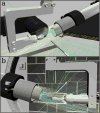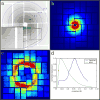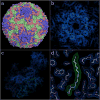High-speed fixed-target serial virus crystallography
- PMID: 28628129
- PMCID: PMC5588887
- DOI: 10.1038/nmeth.4335
High-speed fixed-target serial virus crystallography
Abstract
We report a method for serial X-ray crystallography at X-ray free-electron lasers (XFELs), which allows for full use of the current 120-Hz repetition rate of the Linear Coherent Light Source (LCLS). Using a micropatterned silicon chip in combination with the high-speed Roadrunner goniometer for sample delivery, we were able to determine the crystal structures of the picornavirus bovine enterovirus 2 (BEV2) and the cytoplasmic polyhedrosis virus type 18 polyhedrin, with total data collection times of less than 14 and 10 min, respectively. Our method requires only micrograms of sample and should therefore broaden the applicability of serial femtosecond crystallography to challenging projects for which only limited sample amounts are available. By synchronizing the sample exchange to the XFEL repetition rate, our method allows for most efficient use of the limited beam time available at XFELs and should enable a substantial increase in sample throughput at these facilities.
Conflict of interest statement
A. Meents is one of the CEOs and shareholder of the DESY spin-off company Suna-Precision GmbH. T. Pakendorf and B. Reime are further shareholders. Suna-Precision sells technical equipment for experiments with X-rays including different micro-structured silicon chips for serial crystallography experiments. I. Vartiainen is shareholder and CTO of the company FinnLitho, which produced the silicon chips used for the experiment.
Figures




References
-
- Fry EE, Abrescia NGA, Stuart DI. In: Macromolecular Crystallography: conventional and high-throughput methods. Sanderson MR, Skelly JV, editors. 2007. pp. 245–264.
-
- Fry EE, Grimes J, Stuart DI. Virus crystallography. Mol. Biotechnol. 1999;12:13–23. - PubMed
-
- Hope H. Cryocrystallography of biological macromolecules: a generally applicable method. Acta Crystallogr. Sect. B Struct. Sci. Cryst. Eng. Mater. 1988;44:22–26. - PubMed
Methods References
-
- Roedig P, et al. Sample Preparation and Data Collection for High-Speed Fixed-Target Serial Femtosecond Crystallography. Protocol Exchange. 2017 doi: 10.1038/protex.2017.059. - DOI

